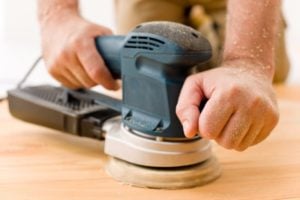[AdSense-A]As is the case with all power tools, always consider safety when sanding. Different types of sanders such as belt and disk sanders have a higher potential for injury or burns than others. Unlike other power tools such as power saws, there is no guard to help minimize any risks.
Below are things to consider before and while operating a sander:
- Utilize OSHA approved eye and face protection which should include safety goggles or safety glasses with shields on the side.
- Most portable sanders have a dust extracting system, but it’s only good if its properly attached and on.
- Most would say that making a simple check of the on/off button before plugging the sander in would be a foregone conclusion, but you’ll be surprised how often this doesn’t happen. It’s easy to guess what’ll happen if the sander is in the on position when plugged in.
- Adhere to the manufacturers recommendations as different widths are suggested for various sanders. Just because the recommended width of one is what you’re used to doesn’t mean it’s all-inclusive.
- As is the cases with all power tools, always keep parts of your body such as hands, hair, face, etc. free from the moving parts.
- Be sure to avoid sanding in areas with clutter and other forms of debris.
- For any unforeseen circumstances, be sure to have a fire extinguisher readily available and that all users are trained on its proper use.
- Be sure the chord is not in the path of the sander itself. Damage to the chord can easily occur when making contact with the sander while it’s engaged which may result in an electrical shock.
- Let the sander do all the work. Sanders are adapted to allow their own weight to create the force needed which should never be in conjunction with one’s own brute force. Forcing a sander the old fashioned way can cause it to overheat, stall, or damage the item being sanded.
- Remember that sanders are powered by electricity; so never operate the sander if it is wet, in areas that are wet, or around liquids.
- Whenever sanding objects such as a board, be sure the board or object is secured properly. Sanding free-moving objects is setting yourself up for injury or the object itself becoming a projectile. Simple clamps, jigs, or the assistance of another individual should be considered.
- Always unplug, clean, and store in a secure location and out of the reach of children.
[AdSense-A]





